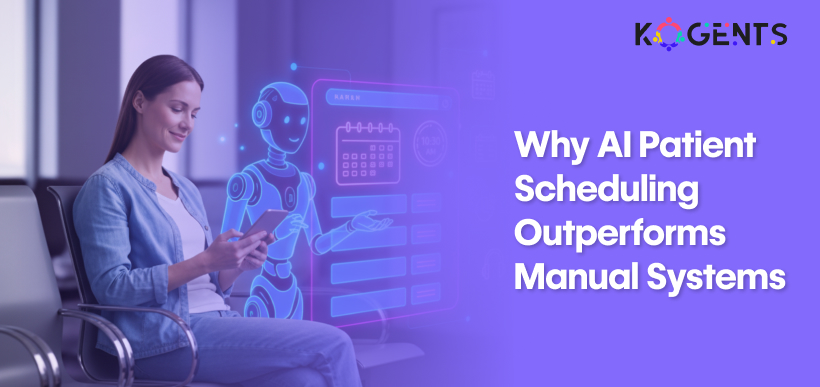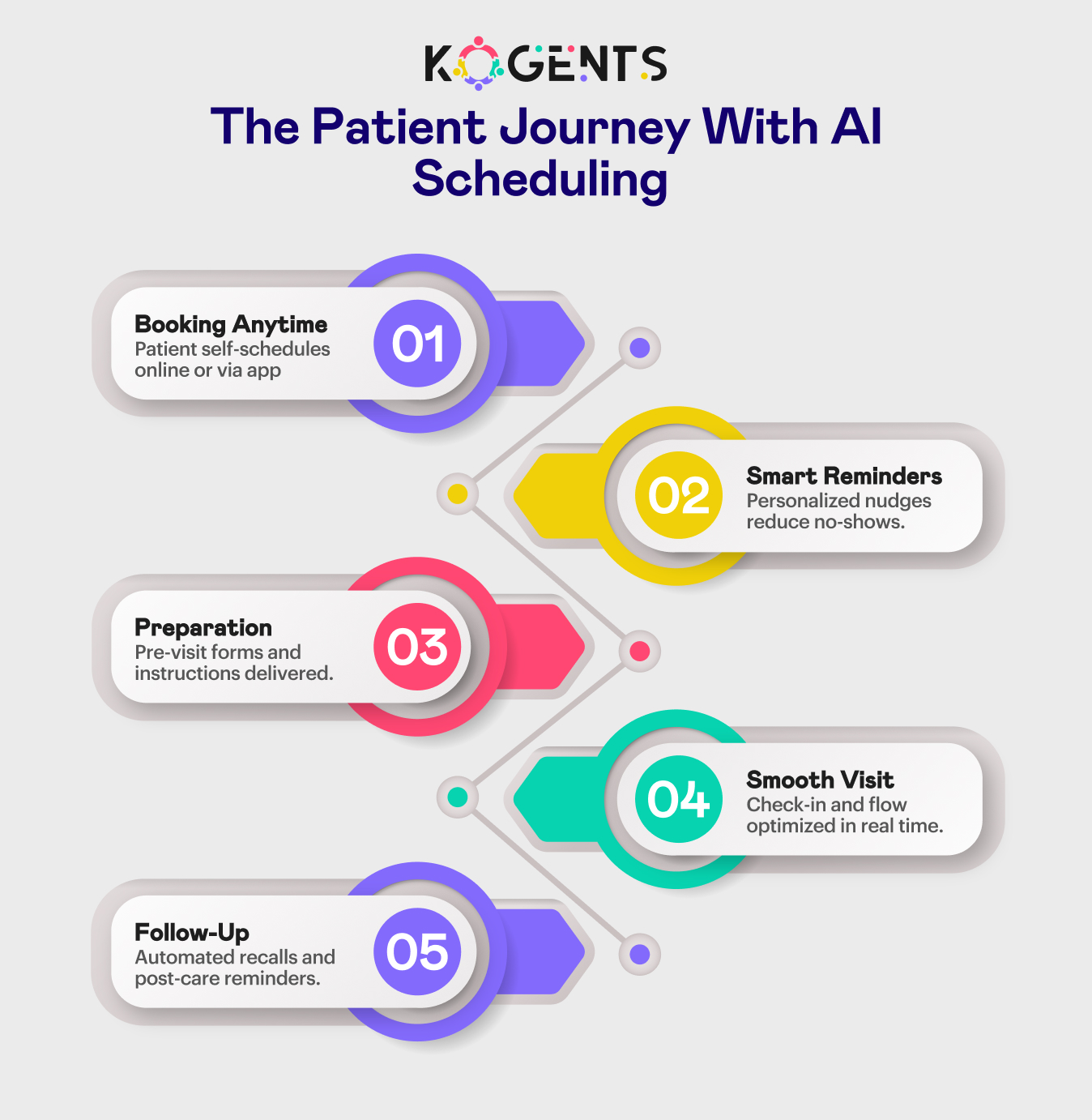Why AI Patient Scheduling Outperforms Manual Systems

Summary:
Behind every patient encounter in healthcare lies a deceptively simple question: When can you come in? While it sounds straightforward, scheduling is undoubtedly the most complex operational challenge in the industry.
Additionally, this results in loss of revenue with delayed care, poorer health outcomes, and overburdened staff scrambling to reorganize.
Traditionally, scheduling relied on phone calls, paper charts, and later, basic digital calendars. These manual systems performed their job, but they are inflexible, full of errors, and sluggish.
Moreover, patients expect consumer-grade convenience, instant booking, quick reminders, and rescheduling options that mirror the experience of reserving a rideshare or dinner table.
This is where AI patient scheduling outcasts all other traditional practices.
By utilizing intelligent agents that automate, personalize, and continuously optimize scheduling, healthcare organizations can transform one of the most frustrating administrative processes into a seamless and patient-friendly experience.
In a system increasingly pressed to do more with less, AI is proving to be not just an improvement but a competitive advantage. Let’s discover and discuss how?
Key Takeaways
- Understanding why manual scheduling leads to inefficiency, errors, and lost revenue.
- Learning how AI scheduling agents automate and optimize appointment booking.
- Exploring the benefits of personalization, smart reminders, and real-time adaptability.
- Seeing how clinics and hospitals reduce no-shows and improve staff productivity with AI.
- Discovering why AI scheduling provides a competitive advantage in modern healthcare.
What is an AI Patient Scheduling Agent?
It is more than a software tool. A profoundly intelligent, autonomous system that acts like a digital health tool or scheduler, capable of reasoning, adapting, and making decisions in real time.
Key Principles of Agentic AI in Scheduling
- Autonomy: It operates independently once parameters are set, and then staff don’t need to micromanage it.
- Goal Orientation: Its mission is clear, and it is to maximize appointment booking efficiency and minimize disruptions.
- Context Awareness: It understands patient preferences, provider availability, and system rules.
- Continuous Learning: It adapts to patient behavior, such as a patient who frequently reschedules or prefers morning slots.
Key Highlight: Unlike static scheduling software, an AI scheduling agent behaves almost like a team member, anticipating needs, responding quickly, and collaborating with other systems.
How an AI Patient Scheduling Agent Works?
From input to action to feedback, the flow typically looks like this:
Input & Context Gathering
- The scheduling process begins by capturing patient intent through multiple channels, such as web, mobile apps, IVR systems, SMS, or WhatsApp.
- At the same time, the system pulls clinical data from the electronic health record (EHR), including procedure codes and provider preferences.
- Operational factors, such as available rooms, equipment, time blocks, and whether the appointment is virtual or in-person, are also considered.
- Policies, such as referral requirements, pre-authorization status, or rules for new versus established patients, further guide the process.
Reasoning & Decision-Making
- Once inputs are collected, the AI applies constraint satisfaction techniques to filter viable appointment slots.
- It predicts no-show risks, accounts for lead time, and balances multiple objectives, such as ensuring timely access, maintaining continuity of care, optimizing resource utilization, and effective patient engagement management.
- Based on this reasoning, the system identifies the most suitable slots and selects the appropriate communication channel for confirmation.
Action
- The chosen appointment slot is booked directly through the EHR or practice management system via APIs (e.g., FHIR Appointment).
- The system then sends confirmations, updates the patient’s digital calendar, and triggers automated reminders through SMS, email, or push notifications.
- Pre-visit forms and instructions are also delivered, ensuring patients are fully prepared.
Feedback & Learning
- After booking, the system continuously monitors confirmations, cancellations, reschedules, and late arrivals.
- These outcomes feed back into the AI’s predictive models, updating no-show risk scores and refining business rules, such as applying overbooking buffers during high no-show periods.
- In addition, analytics are surfaced to administrators, providing insights and recommendations for ongoing schedule optimization.
Integrations:
- EHR/PM: Read/write appointments, patient demographics, orders (e.g., HL7, FHIR Appointment, Slot, Schedule).
- Calendars: iCal/CalDAV or direct provider calendars for coverage and meetings.
- Communications: SMS/voice APIs, WhatsApp Business, email, patient portal messages.
- Identity & Security: OAuth 2.0, SSO, audit logs, encryption at rest and in transit.
Real-World Implementations
A Healthcare Technology study showed that a clinic reduced no-show rates by 30% in six months after adopting AI scheduling.
The system delivered personalized appointment choices and reminders, boosting patient engagement and satisfaction.
- Automation eased staff workload, improving job satisfaction and reducing burnout.
- AI tools adapt over time by learning from feedback and refining scheduling performance.
- Manual methods, by contrast, remain static and less responsive to changing patient needs.
Case Study Example
A pediatric clinic in Dallas implemented an AI scheduling agent integrated with their Epic EHR. Within three months:
- No-shows dropped 23% because reminders were personalized.
- Waitlist management filled 72% of cancelled slots within 24 hours.
- Administrative staff reported saving 15 hours per week, freeing them to focus on patient care coordination.
Soft Reminder: This illustrates how workflow automation delivers both efficiency and human benefits.

Core Features of an AI Patient Scheduling Agent
Automation
- Self-scheduling: Patients find and book appointments 24/7 without staff intervention.
- Smart reminders: Multi-channel nudges based on patient history and channel responsiveness.
- Follow-ups: Automatic recall for labs, imaging, and post-op visits with timing that matches care plans.
Personalization
- Timing fit: Learns when an individual tends to accept slots and offers those first.
- Channel fit: Prefers SMS for fast responders, email for long-form instructions, voice for accessibility.
- Language & tone: Delivers reminders and instructions in a patient’s preferred language and reading level.
Multitasking
- Group & family scheduling: Books siblings together, bundles pre-op and anesthesia consults.
- Reschedules at scale: Handles weather closures or provider illness by re-optimizing affected patients.
- Resource matching: Aligns rooms, devices (e.g., ultrasound), and required staff (e.g., chaperone).
Analytics
- Trends & KPIs: Fill rates, average lead time, first-available access, and denials due to rules.
- No-show heatmaps: By hour, day, location, and visit type.
- Operational insights: Overtime risk, double-booking guardrails, referral leakage, and waitlist conversion.
What You Get? Together, these features create a self-improving scheduling ecosystem, a major leap from manual processes.

Used Cases for Individuals & Businesses
Solopreneurs (Independent Practitioners)
A mental health therapist running a small private practice used to spend two hours each week emailing clients to confirm appointments. After adopting AI patient scheduling, clients book online, receive automatic reminders, and can reschedule without waiting for a reply.
Result: This saves the therapist valuable clinical time and reduces patient frustration.
Clinics & Hospitals
- Support & triage: Route patients to the right clinic line; collect visit reason and urgency; escalate urgent cases.
- Lead capture: Convert website visitors and social leads into scheduled consults in minutes.
- Load balancing: Smooths demand peaks by suggesting alternative sites or telehealth options.
Impact: Reduced call volume, faster access, better throughput across sites.
Teams & Departments
- Cross-department coordination: Orchestrates imaging + specialist + follow-up in one flow.
- Staff coverage: Syncs provider PTO, cross-coverage, and clinic block templates; prevents conflicts.
Impact: Fewer bottlenecks, predictable days, and less burnout from chaotic rescheduling.
Benefits of Using an AI Patient Scheduling Agent
1. Saves Time and Effort
- Administrative staff often juggle hundreds of calls daily.
- By automating this, AI reduces repetitive work and burnout.
2. Increases Productivity
When providers spend less time waiting for patients or dealing with double-bookings, they can see more patients, directly increasing revenue and care access.
3. Offers 24/7 Availability
- Manual systems close with office hours.
- AI patient scheduling agents operate around the clock, capturing bookings while patients are most likely to schedule, often evenings or weekends.
4. Boosts Patient Engagement and Satisfaction
- Patients appreciate convenience.
- Administrators get real-time dashboards that tie directly to operational levers, adding more to better decision-making.
- Also, organizations start with online booking and reminders, then layer in predictive overbooking for high-risk time blocks, then expand to multi-department orchestration.
- Each step compounds ROI.
Unravel the Challenges and Limitations!
- Data security & HIPAA compliance: Protect PHI with encryption, role-based access, least-privilege OAuth scopes, and auditable actions. Ensure BAAs with vendors and rigorous logging.
- API limits & vendor lock-in: EHR and messaging API rate limits can throttle high-volume changes. Design with queueing, backoff, and fallbacks. Favor standards (e.g., FHIR resources) to maintain portability.
- Edge cases need humans: Complex multi-comorbidity cases, ambiguous orders, or social determinant constraints may require staff override. The agent should gracefully escalate with full context.
- Change management: Staff training and policy updates matter. Start with one service line, prove value, then scale.
Key Note: Addressing these proactively keeps AI patient scheduling safe, resilient, and trustworthy.
AI Patient Scheduling Agent vs. Other Agents
Not all “agents” are created equal. Here’s how a clinical-grade scheduling agent compares with common workplace and marketing bots:
| Feature | AI Patient Scheduling Agent | Slack Bots | WhatsApp Assistants | Social Media Tools |
| Primary Use | Healthcare scheduling | Task notifications | Appointment reminders | Marketing automation |
| Data Integration | EHRs, insurance systems | Team calendars | AI scheduling apps for doctors and hospitals | Social platforms |
| Personalization | Deep patient-specific rules | Basic preferences | Limited customization | Audience targeting |
| Automation Depth | End-to-end scheduling | Alerts only | Reschedule + reminders | Posts & analytics |
| Compliance Requirements | HIPAA, GDPR | Low | Moderate | Low |
Healthcare is a highly regulated, high-stakes environment. Unlike general-purpose bots, AI scheduling agents are designed specifically for compliance, accuracy, and clinical integration.
Bottom line: marketing or chatbots can assist around the edges, but AI patient scheduling is purpose-built to align clinical, operational, and regulatory realities.
Under the Hood: Design Patterns That Make It Work
Constraint-aware slotting
- Combine provider calendars
- visit types
- room/equipment
- lead-time rules
- Use constraint solvers to produce feasible schedules in milliseconds
Prediction everywhere
- No-show risk: Models trained on historical patterns (day/time, visit type, weather, distance, channel responsiveness).
- Acceptance likelihood: Personalize slot offers to maximize one-click confirmations.
- Overbooking buffers: Controlled double-booking for high-risk windows with safety limits.
Agentic control loop
- Perception: New inputs (cancellations, lab results, a late MRI).
- Planning: Re-optimize the queue within policy.
- Action: Book, move, notify.
- Reflection: Learn from outcomes to adjust policies.
Interoperability first
Use standards to reduce lock-in and speed integration. For example, the FHIR Appointment and Schedule resources define a common language for slots and appointment bookings.
Future of AI Patient Scheduling Agents
The future of scheduling in healthcare and AI hospital appointment management will look nothing like today’s systems.
- Smarter Prediction
AI will predict which patients are likely to miss appointments and automatically overbook or double-confirm to balance the schedule.
- AI-Linked Diagnostics
Imagine a chatbot that not only books your appointment but also runs a quick symptom check, suggesting the right provider type or urgency level.
- Cross-System Ecosystems
Patients will soon book a consultation, lab test, and pharmacy pickup in a single transaction, all coordinated by AI.
- Agentic AI Collaboration
Multiple AI agents (e.g., for billing, scheduling, diagnostics) will collaborate in real time, managing entire care journeys with minimal staff intervention.
This evolution will transform scheduling from a reactive process into a proactive engine of healthcare delivery, led by the growing role of the healthcare AI agent.
Wrapping Up!
Manual scheduling belongs to another era. In today’s healthcare environment, defined by digital health scheduling and transformation, patient expectations, and cost pressures, AI patient scheduling clearly outperforms manual systems.
The shift brings more efficiency for staff, better access and convenience for patients, and tangible revenue and satisfaction gains for organizations
From the above blog, we conclude that the healthcare leaders of tomorrow are those who embrace these tools today.
So, are you ready to explore what AI patient scheduling can do for your practice? Go to our website at Kogents AI today and drop an email at info@portal.kogents.ai or give us a call at (267) 248-9454 to see intelligent and predictive scheduling in healthcare in action.
FAQs
What’s the quickest way to start with AI patient scheduling?
Begin with one high-volume service line, enable self-scheduling and smart reminders, and measure no-show and fill-rate changes over 60–90 days.
How does AI patient scheduling reduce no-shows?
By predicting risk, offering better-fit times, using the right reminder channels, and maintaining waitlists to backfill late cancellations.
What if the EHR API is limited
Use standards where possible (FHIR). Where not, rely on vendor-supported extensions, batch
What is AI patient scheduling?
AI patient scheduling is the use of artificial intelligence to automate and optimize appointment booking in healthcare. It helps match patients with providers efficiently, reduces no-shows, and improves clinic AI workflow optimization by analyzing availability, preferences, and patterns.
How does AI improve patient scheduling in hospitals?
AI improves scheduling by predicting patient demand, filling last-minute cancellations, balancing provider workloads, and reducing wait times. It also integrates with electronic health records (EHRs) to streamline the process and enhance patient satisfaction.
Benefits of AI for patient appointment management?
Key benefits include reduced no-shows, improved resource utilization, shorter wait times, and better patient engagement. AI tools also provide automated reminders, rescheduling options, and data-driven insights for healthcare administrators.
What is the best AI scheduling software for clinics, and what options exist?
Popular AI scheduling solutions include Epic Systems, Cerner (Oracle Health), Zocdoc, and specialized platforms like Qventus and Relatient. Each offers features such as predictive scheduling, automated reminders, and EHR integration.

Kogents AI builds intelligent agents for healthcare, education, and enterprises, delivering secure, scalable solutions that streamline workflows and boost efficiency.